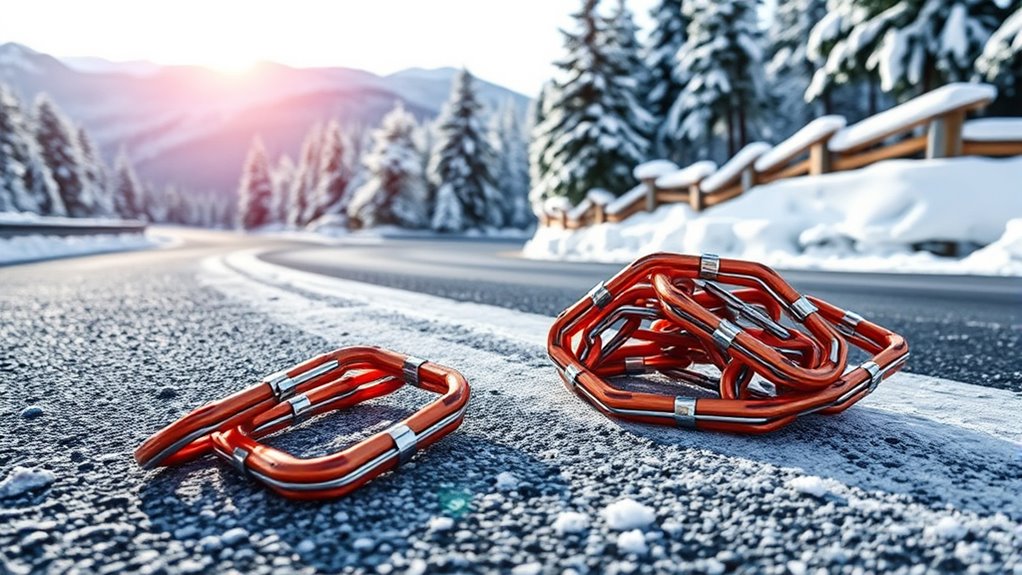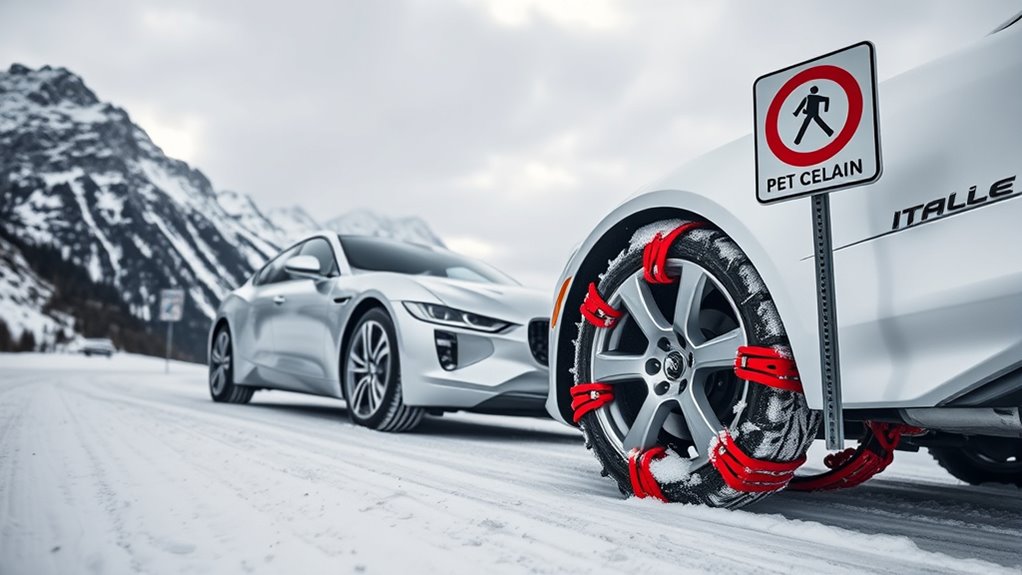In Italy, you need to know that snow chain laws vary by region and road signs indicate when chains or winter tires are mandatory. You must install snow chains on drive wheels when signs require them, and failure to comply can lead to fines. It’s important to carry chains, practice installing them beforehand, and follow local rules to stay safe and legal. Keep going to discover more about Italian winter driving requirements and best practices.
Key Takeaways
- In Italy, snow chains are mandatory in certain mountain areas when road signs indicate, especially from November to April.
- Drivers must fit chains on drive wheels when road signs specify their use; failure can result in fines.
- Winter tires are recommended, but chains are legally required only where signs specify; check local regulations before travel.
- Proper chain installation, including practice beforehand, is essential for safety and legal compliance on snowy or icy roads.
- Always carry gloves and a flashlight for quick, safe chain fitting, and remove chains promptly when no longer needed.

If you’re planning to drive through Italy during winter, understanding the country’s snow chain laws is crucial for a smooth and safe journey. Italy has specific regulations concerning winter travel, especially in mountainous regions, where road conditions can change rapidly. Knowing about winter tire regulations and chain installation guidelines helps you avoid fines and ensures your vehicle is prepared for winter driving.
Driving through Italy in winter requires understanding snow chain laws and regional regulations for safe, compliant travel.
In Italy, winter tire regulations aren’t universally mandated across the entire country but are required in certain areas and conditions. Typically, you’ll need to use winter tires or snow chains when traveling through the Alps and other mountain passes from November to April. These regulations can vary by region, so it’s advisable to check local rules if you’re heading to specific areas. Having winter tires on your vehicle during this period is highly recommended, as they improve traction and braking in snow and ice. If your car isn’t equipped with winter tires, carrying snow chains becomes even more critical. Understanding AI in business can help drivers stay informed about technological tools that enhance safety.
When it comes to chain installation guidelines, Italian law is quite clear. You must know how to properly fit snow chains on your tires, especially if signs indicate their mandatory use. Before setting out, familiarize yourself with your vehicle’s wheel and tire specifications and practice installing chains in a dry, flat area. Proper installation is crucial; chains should be fitted tightly and correctly to ensure safety and avoid damage to your vehicle. Many chains come with specific instructions, so follow those closely. Also, remember that you should only install chains on the drive wheels, typically the front for front-wheel-drive vehicles or the rear for rear-wheel drives.
During your journey, pay attention to road signs indicating when chains are required or when winter tires are mandatory. If you encounter a sign requiring chains, you’re legally obliged to install them before continuing. Failing to comply can result in fines, and driving without chains on icy or snowy roads could compromise safety. Keep a pair of gloves and a flashlight handy for chain installation, especially in cold weather. When removing chains, do so promptly once you’re back on clear roads, as they can damage your tires or vehicle if left on unnecessarily.
Frequently Asked Questions
Are Snow Chains Mandatory Only During Specific Months in Italy?
In Italy, snow chains are not always mandatory year-round. Seasonal regulations and regional differences determine when you must utilize them. Typically, during winter months, especially from November to April, you’ll need to carry snow chains in certain areas. Always check local signs and regulations before driving in mountainous regions, as requirements can vary. Staying informed ensures you comply with the law and stay safe during snowy conditions.
Can I Use Alternative Tire Traction Devices Instead of Chains?
Imagine maneuvering Italy’s snowy passes with confidence—can you replace chains with alternative traction devices? Yes, you can use modern tire solutions like snow socks or anti-skid mats, which are effective and easier to install. However, always check local regulations, as some areas might still require chains in certain conditions. Embrace these innovative options for safer journeys, but stay informed to avoid surprises on Italy’s winter roads.
What Fines Apply if I Ignore Snow Chain Requirements?
If you ignore snow chain requirements during winter driving in Italy, you risk facing hefty fines and legal penalties. Authorities enforce these laws to ensure safety on snowy or icy roads, and failure to comply can result in fines that vary by region. Additionally, you might be compelled to turn back or face delays. It’s best to follow the rules and use snow chains when required, avoiding costly penalties and ensuring your safety.
Are Snow Chains Required on All Italian Mountain Roads?
You don’t need snow chains on all Italian mountain roads; it depends on the chain regulations for specific routes and vehicle types. During winter, authorities may require chains on certain roads, especially for larger or heavier vehicles, to guarantee safety. Always check local signage or road conditions before traveling. If chains are mandated, failing to comply can lead to fines and penalties, so stay informed and prepared for each journey.
How Do I Install Snow Chains Correctly on My Vehicle?
Did you know that improperly installed snow chains can reduce traction by up to 50%? To install them correctly, start by positioning the chains evenly over the tire tread, ensuring they are snug but not too tight. Proper installation involves securing the chains tightly and checking chain tensioning after a short drive. This prevents slippage and damage, keeping you safe on icy mountain roads. Always follow your vehicle’s manual for specific instructions.
Conclusion
Now that you know Italy’s snow chain laws, you’re better prepared for winter drives—no need to summon Merlin’s magic to navigate icy roads. Remember, failing to comply can lead to fines or being stranded like a ship in the fog. Keep your gear ready, stay informed like a trusty squire, and you’ll conquer the Alps with confidence. Safe travels, and may your journey be as smooth as a knight’s steed on freshly paved cobblestones.









